 She's tougher than Tarzan, meaner than Sheena, and lustier than Gungala. 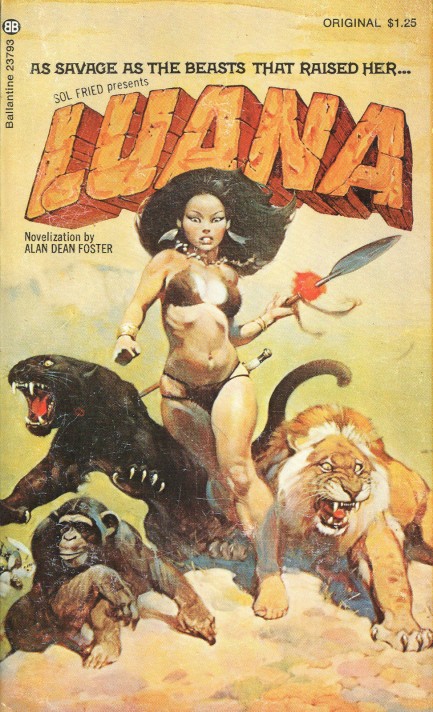
You can look at this cover and correctly assume that we've shared it because it was painted by Frank Frazetta, considered by many to be the master of sword and sorcery art. It's a beautiful piece, rightly famous. Alan Dean Foster is a master too. He isn't what you'd call a significant author in the sense that he's produced lauded original material, but he may be the king of movie novelizations. Among his output: The Black Hole, Clash of the Titans, Outland, Starman, Pale Rider, and The Chronicles of Riddick, as well as novelized series based on Star Wars, Star Trek, and Alien. We love Foster for his Star Wars sequel Splinter of the Mind's Eye, which came out before The Empire Strikes Back (notice we don't bother with that Episode nonsense) and followed Luke and Leia—not siblings in Foster's universe—as they adventured on strange worlds and discovered their love for each other. We still think the film series should have followed Foster's lead, but whatever.
His Luana is a novelization of the 1968 movie of the same name starring Mei Chen Chalais, which we talked about a while back. Sometimes novelizations are published before the film, sometimes after. Foster published Luana six years after the film in 1974 for reasons that are obscure. It was among his first published books. While template for a novelization is provided by the filmmakers, the author is who gives it color and life. Foster fulfills that duty with obvious relish, mining literary and cinematic antecedents like Tarzan, Tarzana, Gungala, Sheena, Shuna, and Ka-Zar for familiar tropes. A kilometer long pit filled with army ants? A lion and panther, both larger than any ever seen before, working in tandem with a huge chimp? A pitched battle between blowgun wielding Tanzanian tribesmen and an expedition of white explorers? A secret city of solid gold buildings? As lost world tales go, by standing on the shoulders of his predecessors, Foster crafts something better than average. And far better than the movie too.
 We had no idea so many would disagree when we called Prometheus incoherent. We'd better explain ourselves. 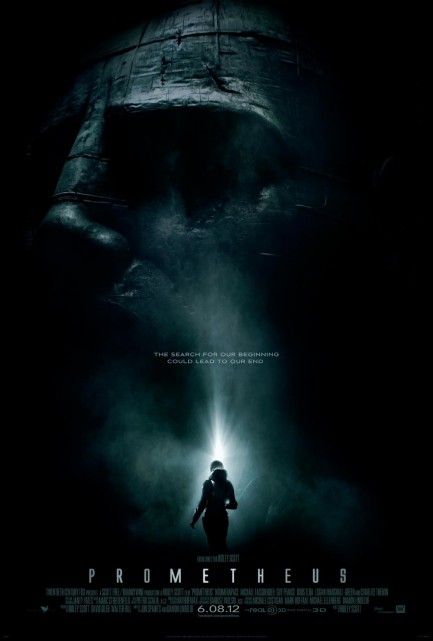
Who’d have thought we’d stir up a hornet’s nest by criticizing Ridley Scott’s Alien prequel Prometheus? We were simply making what we thought was a self-evident statement, but perhaps we’re off in left field on this one. We guess we'd better explain ourselves, and if you actually have the time and/or inclination to read this, we’ll be extremely flattered. First, note that defenders of Prometheus often hail the script’s unanswered questions as a virtue and suggest that haters just need everything spelled out for them. But our dislike of the film had nothing to do with unanswered questions—it had to do with failures of craft. Having been paid during our time in L.A. to write a few scripts, we know a little about story construction. Not that our opinion is any more informed than a perceptive non-writer’s, but for those who require pedigree from their pundits, we have a smidge. Alien worked well for many reasons, but foremost among them was its characterizations. The Nostromo’s crew is intelligent, educated, and experienced. Once they are confronted with a difficult situation, they take appropriate steps—based on the information at hand—to solve the problem. Of course, the true nature of the threat is hidden from them due to the machinations of the science officer Ash, who not only works for the faceless, heartless corporation that has arranged the entire scenario, but is not even human. Thus they never know Kane has an alien embryo in his stomach (they decide the tube down his throat is feeding him air, not impregnating him), which is why they never put him into stasis. This results in Kane’s death. Later they don’t know the alien grows at a miraculous rate. This results in Brett’s death, as he wanders the dark corridors of the Nostromo mistakenly thinking the alien is about the size of a badger. 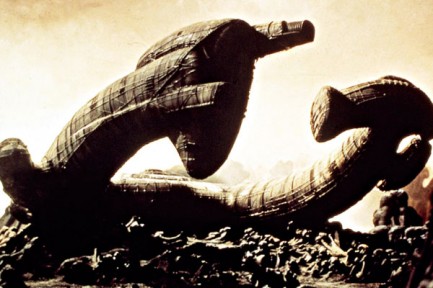 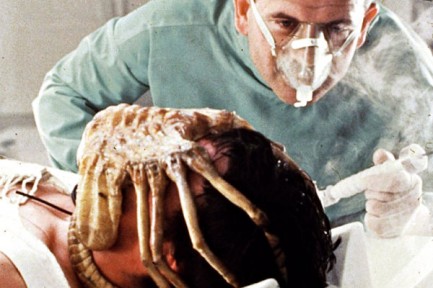  When Brett is killed the crew realizes the threat is something uniquely lethal—Parker, who barely glimpsed it, says. "Whatever it was... it was big and..."—but they still don’t know the creature is intelligent, or at least cunning. They decide that, like any animal, it will flee in a panic from fire. That’s why Dallas ventures into the ship’s ducts with a flamethrower and a plan to force the beast into an airlock. It’s only once he’s in there that the maneuvers of the creature make clear not only that it’s intelligent (or cunning), but that it intends to attack him. But it’s too late to get out. That results in Dallas’s loss. When Brett is killed the crew realizes the threat is something uniquely lethal—Parker, who barely glimpsed it, says. "Whatever it was... it was big and..."—but they still don’t know the creature is intelligent, or at least cunning. They decide that, like any animal, it will flee in a panic from fire. That’s why Dallas ventures into the ship’s ducts with a flamethrower and a plan to force the beast into an airlock. It’s only once he’s in there that the maneuvers of the creature make clear not only that it’s intelligent (or cunning), but that it intends to attack him. But it’s too late to get out. That results in Dallas’s loss. After this, Lambert quite rationally suggests fleeing—but the problem is the shuttle only has room for three. Rather than draw straws and leave one person behind, they decide to continue—with considerably more caution—trying to force the alien into an airlock, but first Ripley seeks more information from the ship’s computer. This is quite rational. Before, it was Dallas who interfaced with the computer. But his loss makes Ripley the captain and she must seek all available information. Ash, fearing either that he’ll be exposed or Ripley will ferret out something useful, decides to stop her, and in the struggle he’s decapitated and unmasked as an android. Now the crew knows the full scope of the challenge. Not only is the monster against them—so is the corporation. But with Ash gone there’s no problem with room in the shuttle, so the survivors make the rational decision to get the hell off the ship. But the alien massacres them as they make the attempt. You’ll note that every link in the chain of decisions is solid and logical. The crew faces a steadily mounting problem and they devise shifting solutions—move, countermove, move, countermove—to deal with that problem as more information becomes available. And having made a  logical decision at every turn, they fail. That’s a big reason why Alien is scary. The characters’ logic in dealing with the problem is unassailable—as it should be, considering their education and experience—yet they still lose. Our sympathy as viewers doesn’t derive from cheap sentiment but from our admiration for the characters’ smart approach to tough circumstances, and our horrific realization that smarts aren't enough to ensure survival. logical decision at every turn, they fail. That’s a big reason why Alien is scary. The characters’ logic in dealing with the problem is unassailable—as it should be, considering their education and experience—yet they still lose. Our sympathy as viewers doesn’t derive from cheap sentiment but from our admiration for the characters’ smart approach to tough circumstances, and our horrific realization that smarts aren't enough to ensure survival. Contrast this with Prometheus. In this you have a group even more steeped in science, yet they behave like teenagers on a field trip to Yellowstone. The entire away party irrationally takes their helmets off because the air in one part of the ancient structure they’re exploring is breathable, but they have no concern for microbes, bacteria, or airborne pathogens. The geologist Fifield irrationally freaks out at the sight of an ancient corpse, and in so doing gets lost in the charnel depths, there to later meet his demise. The zoologist Millburn irrationally approaches and attempts to touch an aggressively behaving unknown species, triggering his demise. The archaeologist Holloway sinks into an alcoholic depression because no living Engineers seem to remain, also leading to his demise, because remember, David spikes a glass of booze with organic goo and gives it to him. Would Holloway have been pounding liquor at all if he’d had enough sense to simply go about his job? We could go on in this vein, but it’s clear to see that Alien relies upon its characters’ intelligence to create the framework for horror, while Prometheus relies upon its characters’ stupidity to set them up as part of the body count. In this way Prometheus doesn’t differ from Friday the 13th, which is why when advocates defend the movie as intelligent we have to chuckle a little. It’s not intelligent—it’s colossally dumb, and we 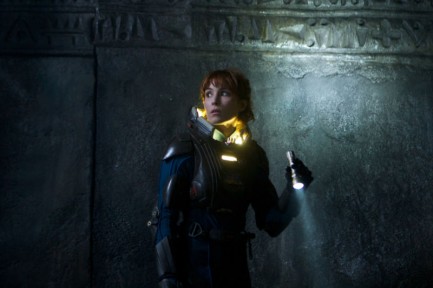 find it quite impossible to sympathize with stupid characters. While Shaw doesn’t do anything overtly ridiculous, neither does she show any analytical genius (at most, we can give her credit for intestinal fortitude and a strong will to survive). She’s a scientist, yes, because the script labels her as such, but the writers couldn’t be bothered to demonstrate her intelligence within the framework of the plot. The same can be said for all the other cardboard cutouts populating the movie. find it quite impossible to sympathize with stupid characters. While Shaw doesn’t do anything overtly ridiculous, neither does she show any analytical genius (at most, we can give her credit for intestinal fortitude and a strong will to survive). She’s a scientist, yes, because the script labels her as such, but the writers couldn’t be bothered to demonstrate her intelligence within the framework of the plot. The same can be said for all the other cardboard cutouts populating the movie. We have a couple more points to make. Why does the prequel have infinitely more advanced technology than the original, which takes place later? The idea of Prometheus as retro-futurism is a tantalizing missed opportunity, not just in terms of production design, but because a lower-tech future similar to Alien’s would have been scarier. But no, the front office types say lights and bells dazzle the masses, so the movie has floating laser probes where Alien, which takes place later, has mostly bolts, jury-rigging, and wishful thinking. It’s pure Hollywood logic. A big budget movie must have gadgetry—period. Thus we have David spying on Shaw’s dreams. What purpose does this intrusion serve? It reveals to him how Shaw’s father died, but he could have gotten that info from a sheet of paper in a manila folder. The scene exists only to flaunt pointless fx. 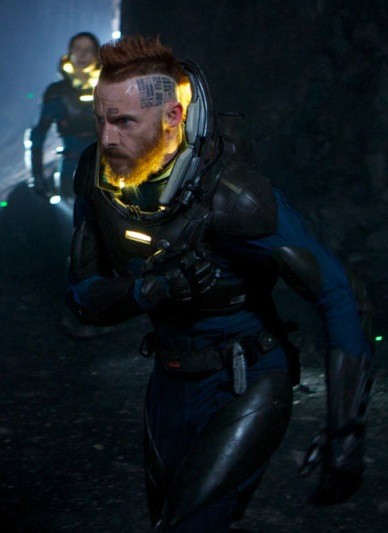 There are a hundred other problems with the movie, from its unneeded intro sequence to its outro of a full grown semi-alien emerging from an Engineer’s body to Meredith Vickers’ hilarious inability to dodge left or right, but we’ll leave all those alone for now. But we do have one last question. When Fifield gets his face burned off and Millburn gets to deep throat an alien worm, why is it Fifield who comes back as a homicidal monster, rather than something that gestated inside Millburn? It’s a very minor point, but it highlights the sloppiness of the script. If the ship must be attacked, why not have it attacked by something that grew from within the character that was obviously implanted by something? This would be efficient story-wise, as well as consistent with the established alien life cycle. By contrast, having the weaponized goo turn Fifield into a monster is extraneous. The movie was so desperate to show an alien that it tacked one onto the end. Why not instead simply have an alien grow inside Millburn and use that creature as the centerpiece of the attack against the ship? Utterly baffling. There are a hundred other problems with the movie, from its unneeded intro sequence to its outro of a full grown semi-alien emerging from an Engineer’s body to Meredith Vickers’ hilarious inability to dodge left or right, but we’ll leave all those alone for now. But we do have one last question. When Fifield gets his face burned off and Millburn gets to deep throat an alien worm, why is it Fifield who comes back as a homicidal monster, rather than something that gestated inside Millburn? It’s a very minor point, but it highlights the sloppiness of the script. If the ship must be attacked, why not have it attacked by something that grew from within the character that was obviously implanted by something? This would be efficient story-wise, as well as consistent with the established alien life cycle. By contrast, having the weaponized goo turn Fifield into a monster is extraneous. The movie was so desperate to show an alien that it tacked one onto the end. Why not instead simply have an alien grow inside Millburn and use that creature as the centerpiece of the attack against the ship? Utterly baffling.
Are we hard on the film? Yes, and everyone should be, because the difference between Prometheus and a low budget sci-fi throwaway is the same as the difference between a street magician guessing your card and David Copperfield making a limousine disappear from onstage at Caesar’s Palace. The breadth of the ambition determines the intensity of the scrutiny. It has always been that way with art, it always will be that way, and it’s completely appropriate. The world expects more of those 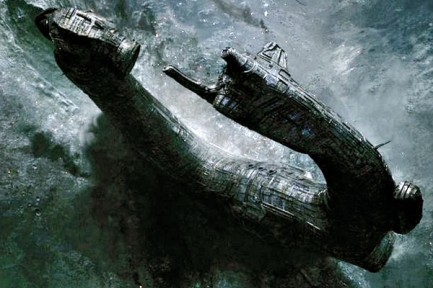 who show great ambition. That’s why a dinky little pulp cover can be praised with the same vocabulary used for the Mona Lisa. Before art can be great it must first meet or exceed the expectations established by its creator or creators. Prometheus was promoted as a scintillating piece of deep-thinking entertainment. While it looks amazing, two viewings of it (we watched it again last night) only make us more certain that it's just a loud, shiny failure. who show great ambition. That’s why a dinky little pulp cover can be praised with the same vocabulary used for the Mona Lisa. Before art can be great it must first meet or exceed the expectations established by its creator or creators. Prometheus was promoted as a scintillating piece of deep-thinking entertainment. While it looks amazing, two viewings of it (we watched it again last night) only make us more certain that it's just a loud, shiny failure.
 There’s a reason she had such a sly expression on her face. 
Here’s a scan from Sidney Skolsky’s This Was Hollywood showing Henri de la Falaise, actress Constance Bennett, and actor Gilbert Roland relaxing in 1933 at the Agua Caliente Hotel in Agua Caliente, Mexico. At the time Bennett was married to de la Falaise. They divorced in 1940 and the next year she married Roland. Knowing that really gives her devilish little smile a deeper meaning, don’t you think?
 Revered French illustrator Jean Giraud dies. 
Sad news just off the wire—unique, prolific, and influential French illustrator Jean Giraud has died aged 73 after a long battle with cancer. Giraud broke onto the art scene in 1965, won his first awards by 1973, and by 1975 had adopted the pseudonym Moebius and developed into a graphic arts master. He worked in the comics medium quite a bit as both a writer and artist, and in addition to nine Marvel/Epic graphic novels, and work on longrunning Marvel characters like the Silver Surfer, was also a regular in the pages of the seminal French sci-fi magazine Métal Hurlant—known in the U.S. as Heavy Metal. Aside from all that, he also worked extensively in motion picture production design, and his efforts helped shape films such as Alien, Willow, Tron and The Fifth Element. It’s been a rough week for the art world—Ralph McQuarrie died less than a week ago. We’ve gathered up a few Giraud/Moebius pieces below so those who don’t know this master can get a sense of his singular style. 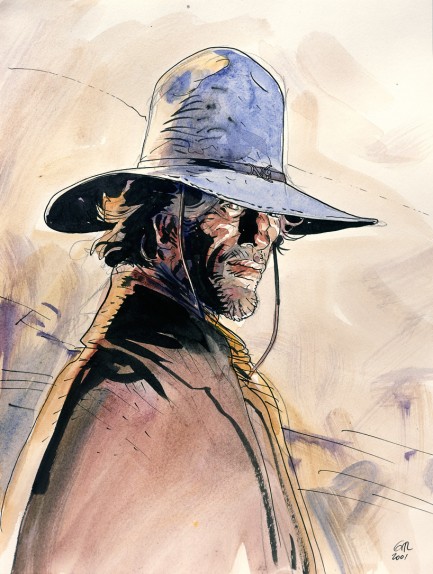 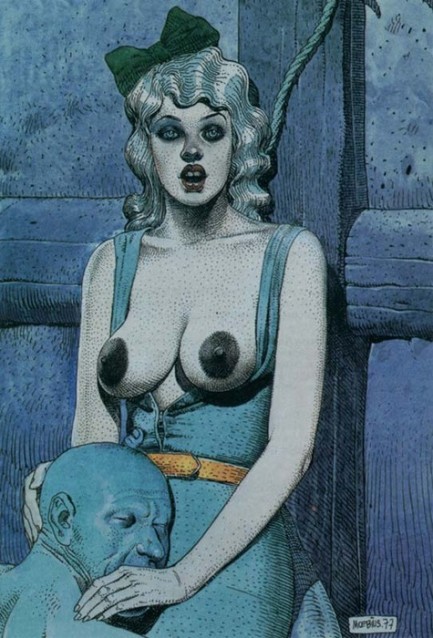  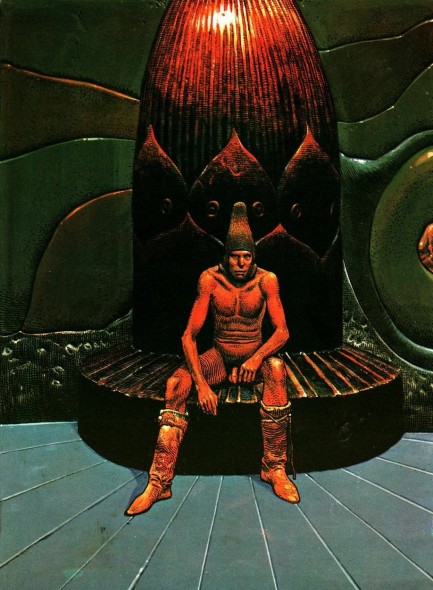 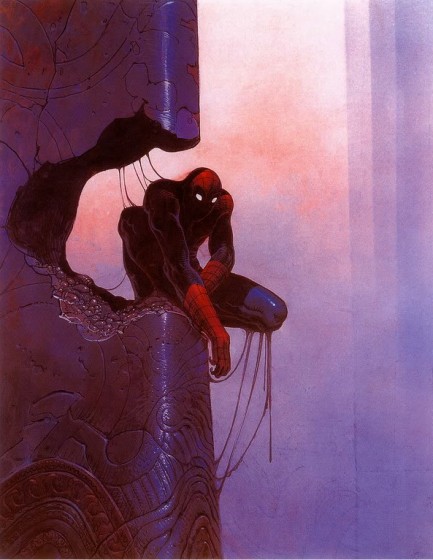 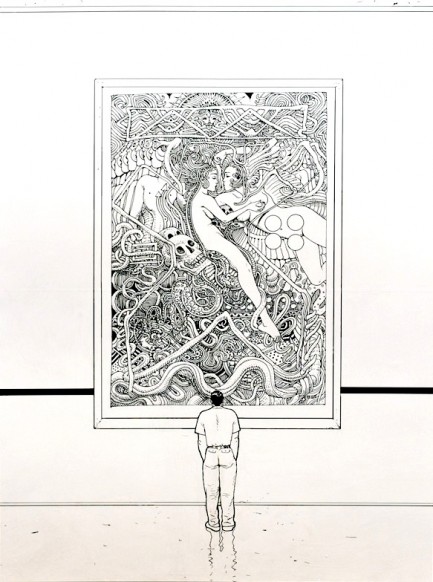 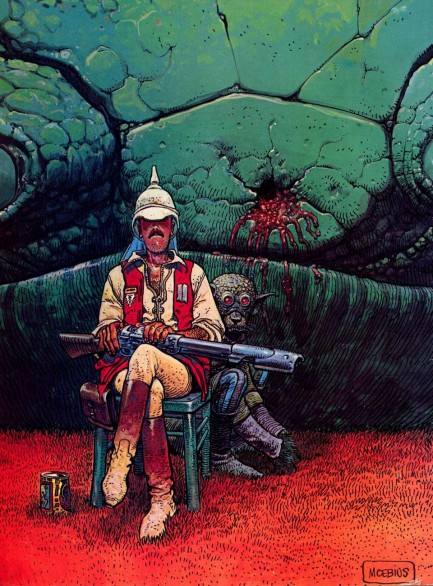 
 Giger retrospective taps into sexual obsessions and primal fears. 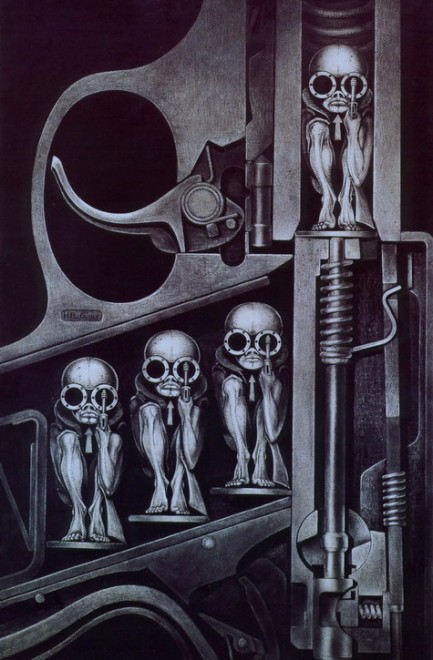
 We’ve always liked the work of biomechanical airbursh artist H.R. Giger—it reminds us of high school, and the anguished sexual obsessions of that time. Most people associate his art with the Alien franchise because he did the production design for the original film, and all the sequels have built upon that foundation. But Giger is about more than just slimy, vicious monsters. For instance, the piece you see above, “Birth Machine,” is quintessential Giger. The crucial clue to its meaning comes from the title. And as we look closely at the piece, we see a pistol in which the bullets are half human creatures who themselves are holding pistols. If we assume each of their pistols in turn contain little bullet men with more guns loaded with more bullet men, we understand that Giger is making a statement about us killing ourselves through overpopulation. In a sense, each of us is a weapon, loaded with deadly ammunition and lacking any sense of restraint that might help us see that our state of perpetual war and environmental destruction derives from the fact that there are simply too damned many of us. Or something like that. We’ve always liked the work of biomechanical airbursh artist H.R. Giger—it reminds us of high school, and the anguished sexual obsessions of that time. Most people associate his art with the Alien franchise because he did the production design for the original film, and all the sequels have built upon that foundation. But Giger is about more than just slimy, vicious monsters. For instance, the piece you see above, “Birth Machine,” is quintessential Giger. The crucial clue to its meaning comes from the title. And as we look closely at the piece, we see a pistol in which the bullets are half human creatures who themselves are holding pistols. If we assume each of their pistols in turn contain little bullet men with more guns loaded with more bullet men, we understand that Giger is making a statement about us killing ourselves through overpopulation. In a sense, each of us is a weapon, loaded with deadly ammunition and lacking any sense of restraint that might help us see that our state of perpetual war and environmental destruction derives from the fact that there are simply too damned many of us. Or something like that. We bring all this up because we saw a Giger exhibit in person at the Kuba Art Gallery in Donostia-San Sebastián, Spain, and the pieces were extremely interesting. They’re otherworldly, yes. Biologically weird, certainly. Relentlessly vaginal, absolutely. Giger is well known for those things. But there’s also a darkness and density to the pieces that is very impressive in person. Their geometry and the physics implied within are Lovecraftian in a sense, which is why we weren’t surprised when we saw that two of Giger’s early pieces were in fact representations from the great horror writer H.P. Lovecraft’s fiction. The exhibit also included a larger than life movie alien menacingly perched on a wall, as well as a macabre dinner table with six biomechanical chairs. If a Giger exhibit ever comes to your town, by all means, go. Any effort will be worth the time and energy spent to see this unique master’s nightmarish work in person. We have more images below, and we apologize for their blurriness, but we were too terrified by the art to focus.
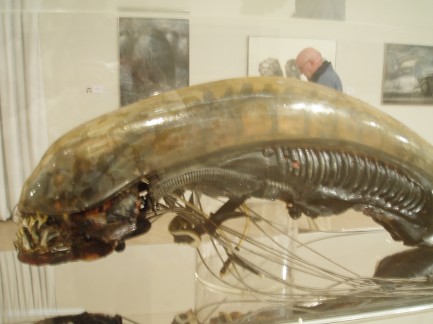  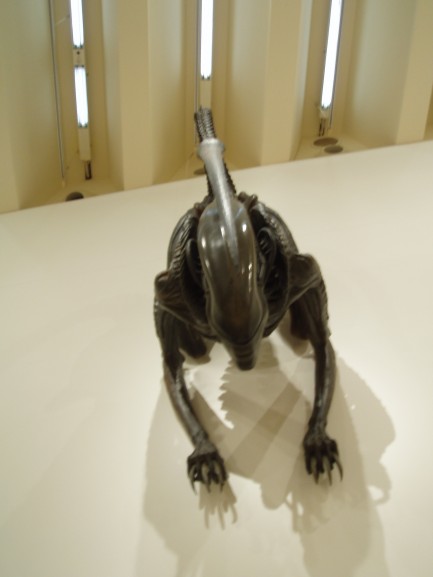 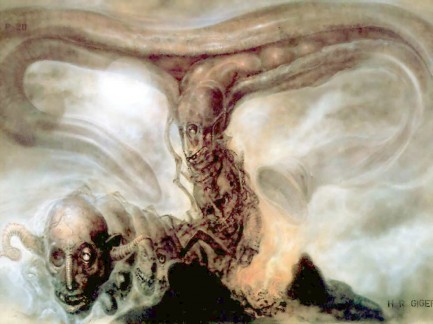 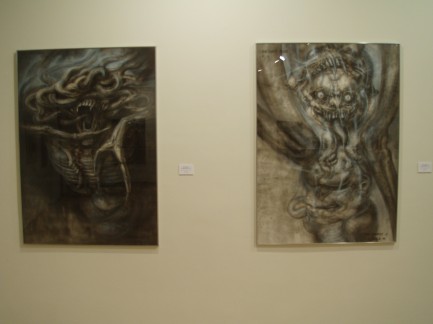 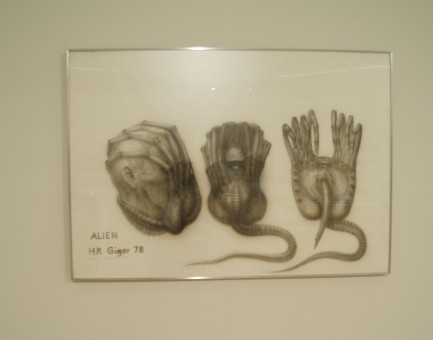 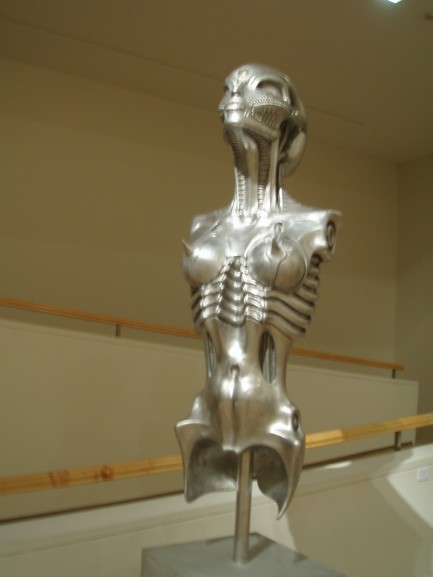
|
 |

The headlines that mattered yesteryear.
2003—Hope Dies
Film legend Bob Hope dies of pneumonia two months after celebrating his 100th birthday. 1945—Churchill Given the Sack
In spite of admiring Winston Churchill as a great wartime leader, Britons elect
Clement Attlee the nation's new prime minister in a sweeping victory for the Labour Party over the Conservatives. 1952—Evita Peron Dies
Eva Duarte de Peron, aka Evita, wife of the president of the Argentine Republic, dies from cancer at age 33. Evita had brought the working classes into a position of political power never witnessed before, but was hated by the nation's powerful military class. She is lain to rest in Milan, Italy in a secret grave under a nun's name, but is eventually returned to Argentina for reburial beside her husband in 1974. 1943—Mussolini Calls It Quits
Italian dictator Benito Mussolini steps down as head of the armed forces and the government. It soon becomes clear that Il Duce did not relinquish power voluntarily, but was forced to resign after former Fascist colleagues turned against him. He is later installed by Germany as leader of the Italian Social Republic in the north of the country, but is killed by partisans in 1945.
|

|
|

It's easy. We have an uploader that makes it a snap. Use it to submit your art, text, header, and subhead. Your post can be funny, serious, or anything in between, as long as it's vintage pulp. You'll get a byline and experience the fleeting pride of free authorship. We'll edit your post for typos, but the rest is up to you. Click here to give us your best shot.

|
|






 When Brett is killed the crew realizes the threat is something uniquely lethal—Parker, who barely glimpsed it, says. "Whatever it was... it was big and..."—but they still don’t know the creature is intelligent, or at least cunning. They decide that, like any animal, it will flee in a panic from fire. That’s why Dallas ventures into the ship’s ducts with a flamethrower and a plan to force the beast into an airlock. It’s only once he’s in there that the maneuvers of the creature make clear not only that it’s intelligent (or cunning), but that it intends to attack him. But it’s too late to get out. That results in Dallas’s loss.
When Brett is killed the crew realizes the threat is something uniquely lethal—Parker, who barely glimpsed it, says. "Whatever it was... it was big and..."—but they still don’t know the creature is intelligent, or at least cunning. They decide that, like any animal, it will flee in a panic from fire. That’s why Dallas ventures into the ship’s ducts with a flamethrower and a plan to force the beast into an airlock. It’s only once he’s in there that the maneuvers of the creature make clear not only that it’s intelligent (or cunning), but that it intends to attack him. But it’s too late to get out. That results in Dallas’s loss.
 logical decision at every turn, they fail. That’s a big reason why Alien is scary. The characters’ logic in dealing with the problem is unassailable—as it should be, considering their education and experience—yet they still lose. Our sympathy as viewers doesn’t derive from cheap sentiment but from our admiration for the characters’ smart approach to tough circumstances, and our horrific realization that smarts aren't enough to ensure survival.
logical decision at every turn, they fail. That’s a big reason why Alien is scary. The characters’ logic in dealing with the problem is unassailable—as it should be, considering their education and experience—yet they still lose. Our sympathy as viewers doesn’t derive from cheap sentiment but from our admiration for the characters’ smart approach to tough circumstances, and our horrific realization that smarts aren't enough to ensure survival.
 find it quite impossible to sympathize with stupid characters. While Shaw doesn’t do anything overtly ridiculous, neither does she show any analytical genius (at most, we can give her credit for intestinal fortitude and a strong will to survive). She’s a scientist, yes, because the script labels her as such, but the writers couldn’t be bothered to demonstrate her intelligence within the framework of the plot. The same can be said for all the other cardboard cutouts populating the movie.
find it quite impossible to sympathize with stupid characters. While Shaw doesn’t do anything overtly ridiculous, neither does she show any analytical genius (at most, we can give her credit for intestinal fortitude and a strong will to survive). She’s a scientist, yes, because the script labels her as such, but the writers couldn’t be bothered to demonstrate her intelligence within the framework of the plot. The same can be said for all the other cardboard cutouts populating the movie. There are a hundred other problems with the movie, from its unneeded intro sequence to its outro of a full grown semi-alien emerging from an Engineer’s body to Meredith Vickers’ hilarious inability to dodge left or right, but we’ll leave all those alone for now. But we do have one last question. When Fifield gets his face burned off and Millburn gets to deep throat an alien worm, why is it Fifield who comes back as a homicidal monster, rather than something that gestated inside Millburn? It’s a very minor point, but it highlights the sloppiness of the script. If the ship must be attacked, why not have it attacked by something that grew from within the character that was obviously implanted by something? This would be efficient story-wise, as well as consistent with the established alien life cycle. By contrast, having the weaponized goo turn Fifield into a monster is extraneous. The movie was so desperate to show an alien that it tacked one onto the end. Why not instead simply have an alien grow inside Millburn and use that creature as the centerpiece of the attack against the ship? Utterly baffling.
There are a hundred other problems with the movie, from its unneeded intro sequence to its outro of a full grown semi-alien emerging from an Engineer’s body to Meredith Vickers’ hilarious inability to dodge left or right, but we’ll leave all those alone for now. But we do have one last question. When Fifield gets his face burned off and Millburn gets to deep throat an alien worm, why is it Fifield who comes back as a homicidal monster, rather than something that gestated inside Millburn? It’s a very minor point, but it highlights the sloppiness of the script. If the ship must be attacked, why not have it attacked by something that grew from within the character that was obviously implanted by something? This would be efficient story-wise, as well as consistent with the established alien life cycle. By contrast, having the weaponized goo turn Fifield into a monster is extraneous. The movie was so desperate to show an alien that it tacked one onto the end. Why not instead simply have an alien grow inside Millburn and use that creature as the centerpiece of the attack against the ship? Utterly baffling.
 who show great ambition. That’s why a dinky little pulp cover can be praised with the same vocabulary used for the Mona Lisa. Before art can be great it must first meet or exceed the expectations established by its creator or creators. Prometheus was promoted as a scintillating piece of deep-thinking entertainment. While it looks amazing, two viewings of it (we watched it again last night) only make us more certain that it's just a loud, shiny failure.
who show great ambition. That’s why a dinky little pulp cover can be praised with the same vocabulary used for the Mona Lisa. Before art can be great it must first meet or exceed the expectations established by its creator or creators. Prometheus was promoted as a scintillating piece of deep-thinking entertainment. While it looks amazing, two viewings of it (we watched it again last night) only make us more certain that it's just a loud, shiny failure. 













 We’ve always liked the work of biomechanical airbursh artist H.R. Giger—it reminds us of high school, and the anguished sexual obsessions of that time. Most people associate his art with the Alien franchise because he did the production design for the original film, and all the sequels have built upon that foundation. But Giger is about more than just slimy, vicious monsters. For instance, the piece you see above, “Birth Machine,” is quintessential Giger. The crucial clue to its meaning comes from the title. And as we look closely at the piece, we see a pistol in which the bullets are half human creatures who themselves are holding pistols. If we assume each of their pistols in turn contain little bullet men with more guns loaded with more bullet men, we understand that Giger is making a statement about us killing ourselves through overpopulation. In a sense, each of us is a weapon, loaded with deadly ammunition and lacking any sense of restraint that might help us see that our state of perpetual war and environmental destruction derives from the fact that there are simply too damned many of us. Or something like that.
We’ve always liked the work of biomechanical airbursh artist H.R. Giger—it reminds us of high school, and the anguished sexual obsessions of that time. Most people associate his art with the Alien franchise because he did the production design for the original film, and all the sequels have built upon that foundation. But Giger is about more than just slimy, vicious monsters. For instance, the piece you see above, “Birth Machine,” is quintessential Giger. The crucial clue to its meaning comes from the title. And as we look closely at the piece, we see a pistol in which the bullets are half human creatures who themselves are holding pistols. If we assume each of their pistols in turn contain little bullet men with more guns loaded with more bullet men, we understand that Giger is making a statement about us killing ourselves through overpopulation. In a sense, each of us is a weapon, loaded with deadly ammunition and lacking any sense of restraint that might help us see that our state of perpetual war and environmental destruction derives from the fact that there are simply too damned many of us. Or something like that.










































































